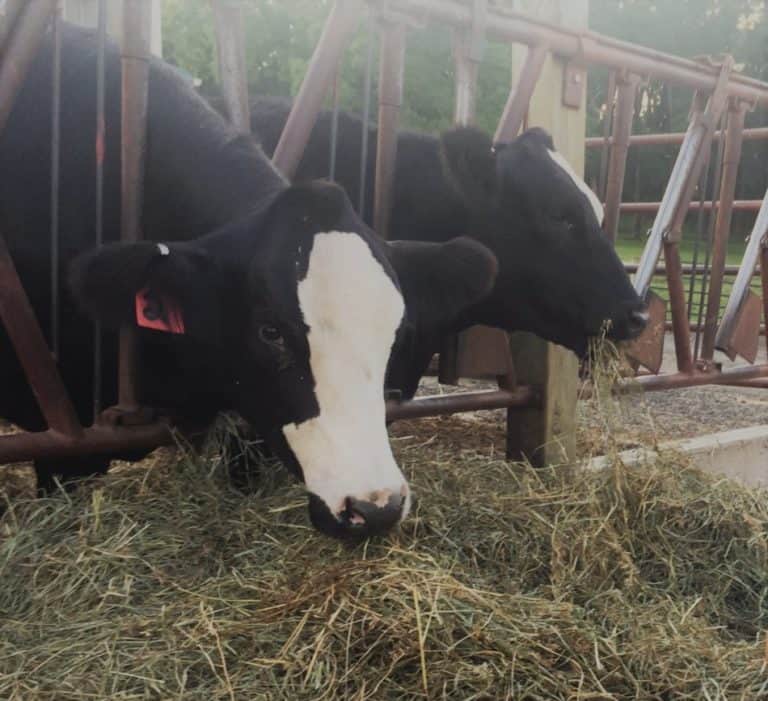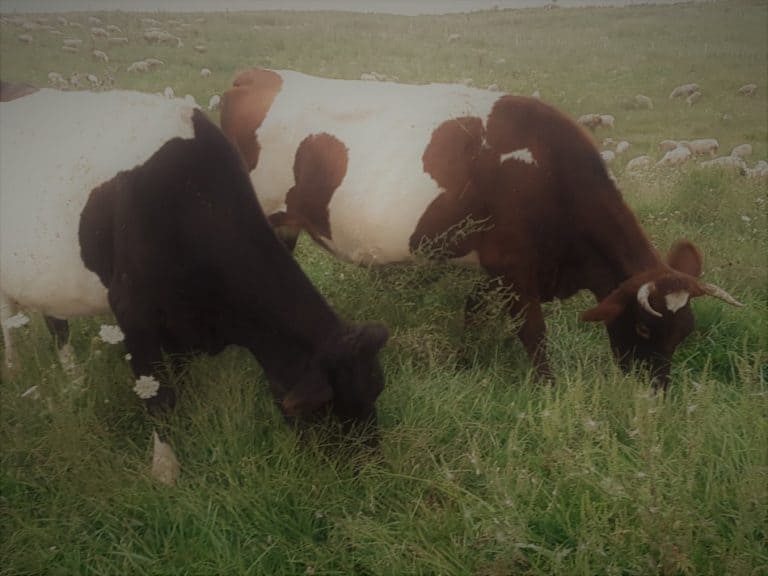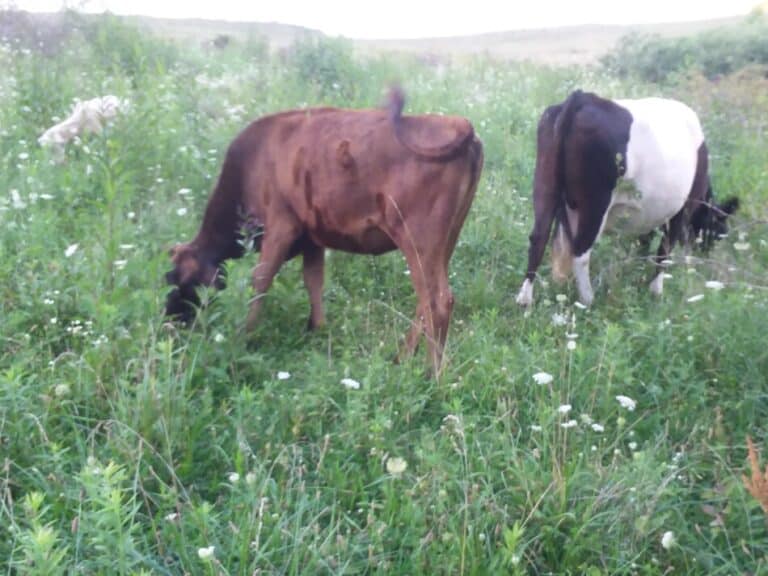Why Do Cattle: Eat Dirt, Stampede, Bellow And More
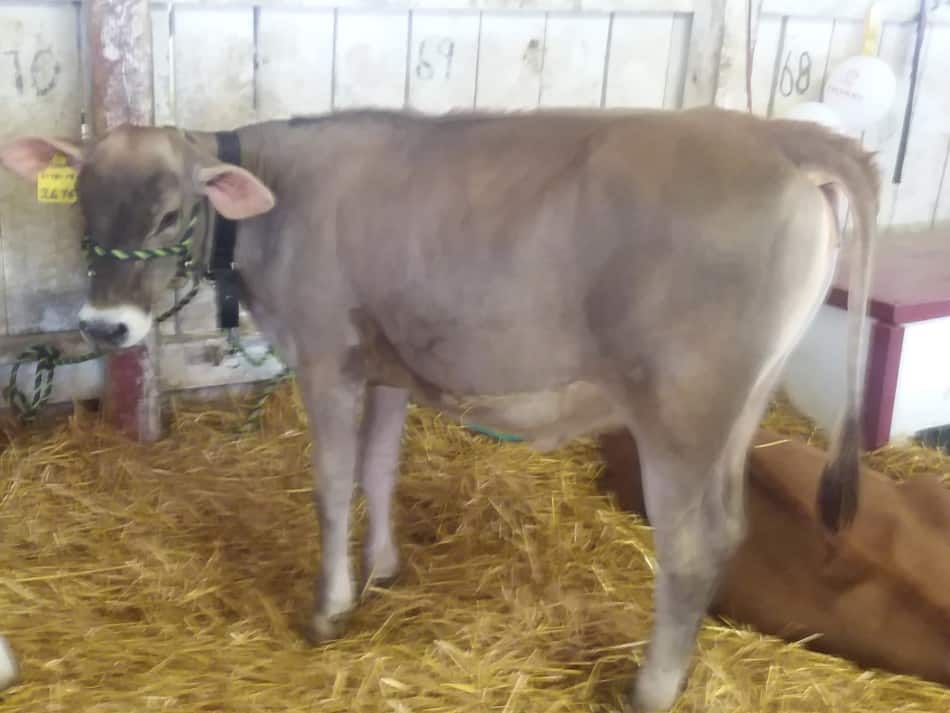
Sometimes cattle can be seen doing a few unusual things, like eating dirt or staring at people. What are they up to and why?
All cattle, regardless of breed, have certain behaviors we see them doing, like eating dirt or bellowing, that make us wonder what exactly are they up to.
Life Of A Dairy Cow is an article going over the daily routine of a cow, if you are interested in learning more.
Cattle huddle to feel safe
For cattle everything is a group activity.
Cattle feel safer in groups since they are more protected from predators when they are all together.
Frequently, cattle huddle tightly together to block the wind or to be warmer.
This is the same thing as people standing in a crowd, some get all of the wind the rest don’t get any since the first few rows of people blocked it out.
Understanding Flight Zone And Point Of Balance is an article on Grandin.com that goes over low stress handling techniques for cattle, sheep and pigs.
Cattle eat dirt for the nutrients
When cattle eat dirt they are wanting to get some nutrient that they can tell is in the soil that they instinctively know they need more of.
Quite commonly cattle lick the spot where a salt and/or mineral block used to be since it dissolved into the soil below where the block was placed.
If they want more of the mineral and the block has not been replaced, the best way to get the mineral is to “eat” the dirt in that spot.
They are not eating the dirt to get the dirt. They want the salt or minerals and the only way to get the salt or minerals is by eating the dirt as well.
Why Do Cattle Need Salt? goes over the unexpected benefits of making sure your cattle have access to salt any time they want it.
Cattle are a special kind of herbivore called a ruminant.
Herbivore means plant eater. Cattle do not eat meat.
Ruminant means they have a specialized digestive system that allows them to live on forages alone and they chew their cud.
Other animals that are both herbivores and ruminants include sheep, goats and deer.
Looking for more information? Check out my article Why Does A Cow Eat Grass for a more in depth explanation.
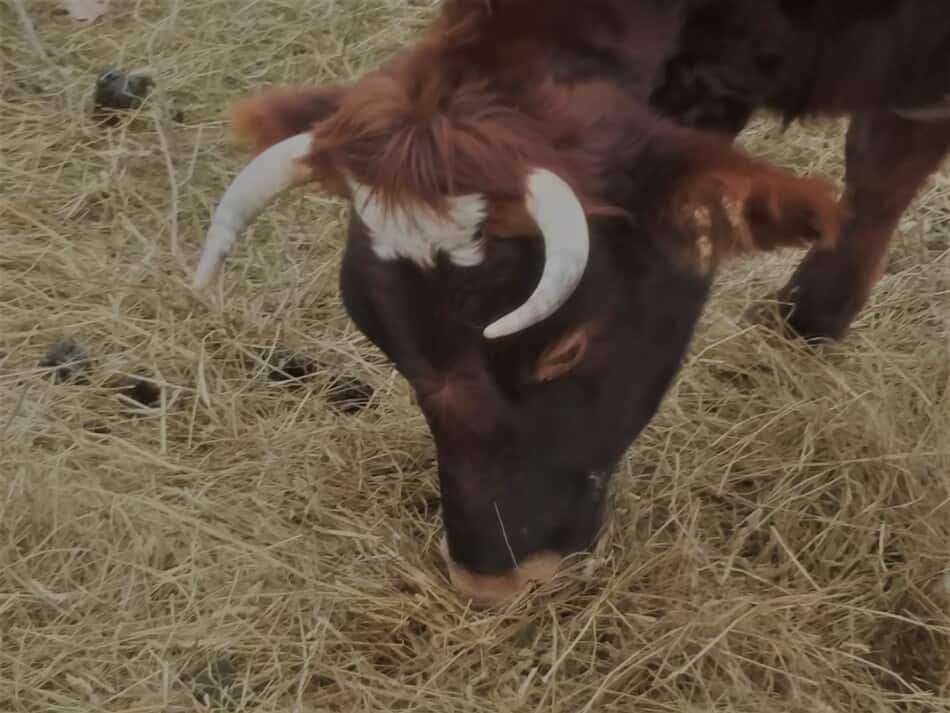
Cattle do not have four stomachs
Cattle have one stomach. Just one.
This whole four stomach thing is a prevalent misunderstanding of cattle basics that is unfortunately all over the internet.
Here’s the scoop: cattle have one stomach that is divided into four sections. The sections are rumen, reticulum, omasum and abomasum.
Think of it like your house or apartment.
You have one place that you live (the house) but it has different rooms within the house that you consider to be separate sections like kitchen, bathroom, bedroom and so on.
Even though the rooms are separate they are still in the same house. Just like cattle have one stomach (house) with multiple sections (rooms).
The amazing thing about having a four compartment stomach means the cattle can use plants for energy that animals with a simple stomach can not use for energy.
This ability is the reason why cattle are versatile and valuable in many areas where transporting feed into the area is not a feasible option for most of the residents.
Cattle Grazing: Using Grass To Feed Your Herd goes over why cattle are all star grass eaters and how they can be used to get the best use out of your land.
The herd of cattle face the same direction
Cattle are all groupies. They love to be part of the herd and function as such. Partially, it is a safety thing, but it is also a food thing.
When one cow or steer finds something tasty the others will want some of it too. Think of kids and candy, any one that sees the candy wants a piece or two.
If given enough room cattle also tend to make a loop around the grazing area in search of the best grass and tasty regrowth.
They will have a route that they walk to check everything out. They are all facing the same direction because they are all walking the grazing route.
Cattle bellow to get noticed
Generally, cattle that are bellowing are upset, frustrated or just plain begging for snacks.
If cattle are used to being fed at a certain time and you are late they will bellow.
If they know it is feeding time and you choose to feed other livestock first, cattle of course think they should be first, they will bellow.
If they see you roaming about the barnyard and are feeling like you should refresh their hay supply (whether they actually need it or not) they will bellow.
This is just like your dog wanting more treats, it’s not hunger she just wants the treats.
Sometimes, when a cow or heifer is coming into heat she will bellow, there’s nothing weird or wrong, it’s just hormones.
When a calf has been weaned or separated off of the herd it will bellow. This is why cattle bellow at the sale yard.
It is confusing and new, so they are trying to figure out what is going on. Cattle like routine, not change (unless the change is new food then they are all in).
When you split the group to keep certain cattle inside the barn and let others out, the ones left inside will bellow.
Individual cattle have personalities
All cattle are individuals with their own personalities just like cats or dogs.
Overall, breeds seem to have common personality characteristics like some breeds tend to be more high strung than others, while other breeds are known for being calm.
But not all individual cattle of a certain breed will act exactly the same. For instance, some cattle like to be around people and some don’t.
Your dogs (or any other pets) do not all act exactly alike in any situation.
Dogs of the same breed all have distinct personalities even when raised by the same people. This is true for other pets and cattle as well.
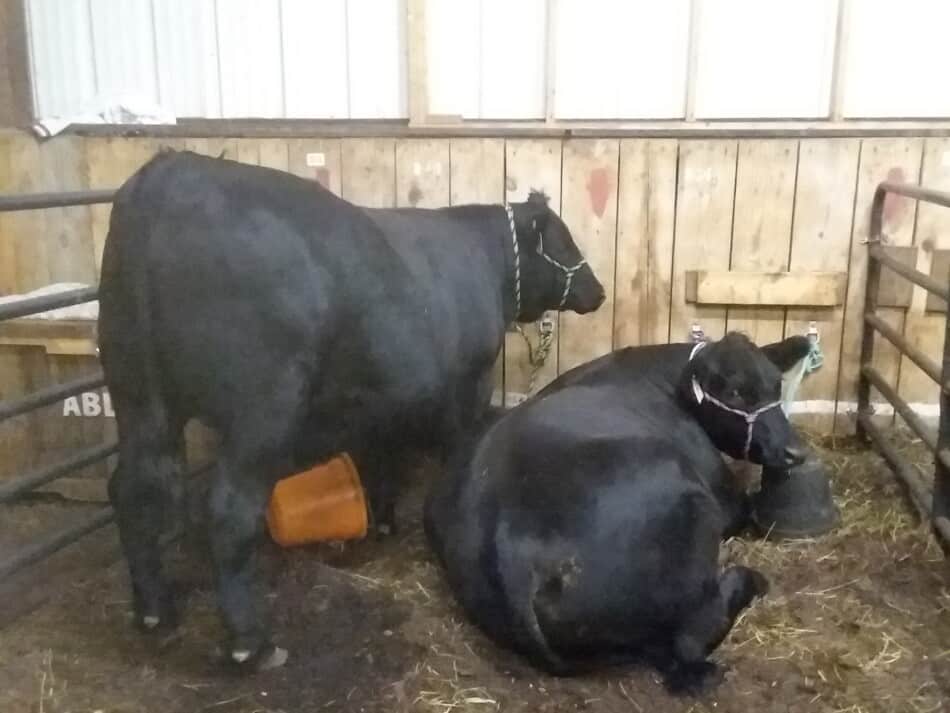
Cattle sleep every night
Yes, cattle sleep every night. Cattle like to lay down to sleep.
If a cow has her eyes closed but is still chewing her cud she is not asleep she is just very relaxed.
Cattle prefer certain areas of the barn or pasture to sleep in.
Most cattle will pick a place that is comfortable, so sheltered from any wind if it is cold or where they can catch a bit of a breeze if it is hot.
Cattle need to sleep with their feet down hill from their bodies and the head up hill, obviously nothing to worry about here if your land is flat.
Feet down hill makes it so she can easily get up in the morning. What does it matter where her feet are compared to her body, you ask?
With her feet uphill or her head downhill she would run the risk of bloating, which is potentially fatal.
Cattle like to lay down to sleep
To get a good night’s sleep, cattle need to lay down.
Cattle can sweat
Yes, cattle do sweat. Sweating cools the body of cattle, just like for people.
Without a reliable method of cooling down in hot weather cattle could not live in many of the areas where they are currently the most popular.
Cows have a great sense of smell
How good is a cow’s sense of smell? Pretty darn good.
Cattle can smell odors coming from up to six miles away!
Cattle don’t smell their way to water
While I have heard of cattle being able to smell water before, I do not know of anyone with proof that cattle can smell their way to water when they are in an area unfamiliar to them.
Cattle naturally will wander about scoping out an area and love to follow trails that are cut into the dirt.
Since most animals that would be tracking up a trail would also need water, it makes sense that a trail will lead to water.
I can not find confirmation that they can “smell” the water, it seems to be more a case of if it’s good for all those other animals (that made the trail) I bet it’s going to be good for me too.
How can you tell if a cow is happy?
A happy cow is relaxed and chewing her cud. If she is standing you will see horizontal ridges along the lower part of her stomach called “happy lines”.
These are raised lines, kind of like a stretch mark, that show up when a cow is chuck full of good food, meaning she has everything she needs to eat and that makes her happy.
Cattle are not native to the U.S.
The cattle of today are descended from ancient cattle first domesticated in the “fertile crescent” of modern day Iraq, Jordan, Syria, and Israel.
The animal domesticated was an auroch, which is a huge wild bovine 1.5 to 2 times the size of modern cattle.
The first cattle, as we know them, were brought here in 1493. Cattle are not native to the U.S.
Cattle are not color blind
Cattle can see some color so they are not color blind.
However, cattle can not see much in the way of color and definitely not the colors that we see. They see black, gray, white, and muted blues and greens.
What about the red cape waved around by the matador in a bullfight? The bull can not see the color, it is the motion of the flag and the matador that are getting his attention.
Any color flag would work here, red is just the traditional color used.

Cattle activity depends on the breed
Depending upon the breed some cattle are more active than others, but all cattle like exercise and room to move around.
The best way for cattle to grow and be happy is to live a more relaxed life.
There are times in the life of a cow that will be very active like moving to a new pasture, when they get grain or new hay or when they have a calf, but overall low stress is better for them.
This is just like people. We all need a balance between activity, stress and being a couch potato.
Cattle have horns because of genetics
Cattle that have horns got the gene for being horned from both parents. Just like you got the genes for the color of your eyes or the shape of your nose from your parents.
Horns are a recessive trait. Recessive means the trait can be covered up physically (you don’t see it) by a dominant trait.
Recessive is the opposite of dominant. A recessive trait has to come from both parents to show up in the offspring.
Some genes will blend, so they are not dominant or recessive. The results show up somewhere in the middle like parents with different eye colors, the child will have an eye color somewhere in the middle.
Since horns are recessive, it is either all or nothing when looking at the animal.
Genetically the cow is actually half horned, but when you look at her you do not see horns. With certain traits like horns there is no half, the cow either has them or she does’t.
Cattle horns made of keratin
Believe it or not, horns are actually very similar to hair since both horns and hair are made of keratin.
Horns do not make cattle dangerous
We have had feisty polled cattle (no horns) and docile horned cattle. It’s not the horns that make the difference, it’s the attitude.
Any cattle that are dangerous have an aggressive attitude. This can happen with polled (no horns) or horned cattle.
We have had a mix of horned and polled cattle living together and the cow highest up in the social order is rarely the horned one.
Cattle have different vision than us
Compared to our eyesight, cattle have better vision … and they have worse vision than us.
What this really means is that cattle see differently than people.
Part of this is because our eyes are oriented to the front, while cattle and other typically prey animals have their eyes out on the sides of their heads.
Cattle have panoramic vision, meaning she can see nearly all the way around her at once. The only area she can not see is directly behind her.
On the other hand, cattle are very poor at depth perception, meaning a shadow on the floor or an actual hole (like a pothole) look the same to them.
This issue of different depth perception than us is usually only a concern when trying to move cattle through a gate system, since some of the openings that look obvious to our eyes are hard to see for the cow.
If she can’t see the open doorway then she won’t move towards the opening to leave, because to her eyes there is no where to go.
Cattle will raise their heads up and down to try to find the position where they can see best.
Cattle can see at night
Cattle and many other animals, like cats and dogs, have a reflective surface in their eyes that allows them to make the most of even the smallest amount of light at night.
Cattle can see much better at night than we can.
Cattle can kick behind themselves
Yes, they sure can kick behind themselves!
Cattle can also kick to the side.
Cattle will be more likely to kick when they are nervous, hurt, or had a past experience of rough handling.
Cattle have intelligence
Are cattle intelligent? This is a tough one, since the word intelligent can mean different things.
Cattle tend to be slow and determined, so this can be interpreted as not very smart. Cattle also will automatically follow the herd, maybe to do something we would consider dumb, which will also be seen as lacking intelligence.
On the other hand, cattle can be very kind and gentle. They know who their herd mates are and who is new. A cow knows which calf is hers, even in a big, possibly huge, herd.
If you mean are cattle smart like a dog that is really quick to learn new tricks and commands, then no cattle are not intelligent.
If by intelligent you are meaning that the animal has a personality, can make choices, will act differently according to the situation, can recognize people and will learn a routine, among many other things, then yes they are intelligent.
Cattle have a good memory
Cattle know exactly where they need to go to find the best grazing, shelter and water once they have had time to explore a pasture area.
She also knows exactly where her calf is all the time, even if it is out of her sight.
Cattle will also remember and recognize people they have seen before.
With dairy cattle for instance, they know if you are new, since you are not the one who did the milking last night.
Dairy cattle will be more relaxed for a person they know and feel comfortable being around during milking.
Cattle stampede because they react first, then look
Once again, the basic nature of the cattle feeling most secure in a group is at the heart of this behavior.
Cattle count on the other animals in the group to be looking for changes or happenings that could be threats just as the individual cow herself is looking around to monitor the area.
When one cow sees a something she interprets as a threat (or just a big surprise) she does’t know what to think of it and they run from the threat.
Once the group gets going they all are running because the animal beside them is running so this is a self perpetuating situation for a little while.
Sometimes the cattle just feel really high energy and they run around a bit, like your cat just zooms across a room once in a while.
You will see high tails and the cattle kind of bucking around as they run. These gals are just feeling feisty.
This is not the same as running out of fear. The playing around “stampede” will not be as intense or as long lasting as a stampede that is fear induced.
You can not outrun a cow
You can not outrun a cow. The best thing to do is to not put yourself in the situation where outrunning an animal is necessary.
For the most part cattle are not aggressive towards people, it wouldn’t make sense for a farmer or rancher to keep an animal that spends it’s day trying to kill him.
But there are individual animals and specific situations where cattle can hurt you.
Most cattle do not like dogs, some bulls are much more territorial than others and moms with babies are always on alert.
Going into the pasture or pen of an animal means you went to the animal’s home and are willing to accept responsibility for your actions.
Cattle stare to figure out what they see
Cattle are herd animals that stay alive by noticing anything unusual and you are something to be noticed.
They are not staring because you are a person.
They are staring because you are something new to their environment and they are curious about anything new.
Calves wag their tails, cows swat flies
Young calves that are nursing will wag their tails as they are drinking milk, from their mom or from a bottle.
Adults and weaned younger stock really only wag their tails to swat flies off their backs.
Sometimes cattle that are just relaxing, laying down and chewing their cuds will flick the end of their tail.
Cows can sit, but normally don’t
Yes they can sit, but it is not a position they are normally in. If she is sitting like a dog, she can not stand up directly from that sitting position.
In order to stand up the cow rocks forward on her knees, pops up her rear end and then stands by straightening out her front legs.
To lay down she goes in the opposite order.
Cattle are natural, not GMO
Yes, cattle are natural. Any animal that came from parents that can mate with each other and reproduce all on the farm (no lab coats needed) is natural.
If you are leaning towards that fact that cattle and other domestic animals have been selected for traits that would not have been helpful in the wild, like high milk production in dairy cattle, that is still natural.
Higher milk production could have happened on it’s own with out selecting specific breeding stock. Granted, it is unlikely but it is possible.
What would be unnatural is using genes from other species that are spliced into cattle (or any other plant or animal)that could not have gotten into the cattle without major human interference.
For example putting genes from insects into plants. This is real look up glowing tobacco plants, a tobacco plant with firefly genes spliced into the plant.
This type of unnatural gene modification can only be done in a lab, not on a farm.
This unnatural gene manipulation is how GMO’s (genetically modified organisms) are made.
GMO’s can only be lab “created” they can not be found in nature or as a result of natural breeding of livestock.
Cattle breeds are commonly crossed
Yes, it is very common for cattle breeds to be crossed on purpose to produce a hybrid (a mix) of the two parent breeds.
These crosses are very popular as range animals and with cattle enthusiasts, alike.
Cattle will also readily cross breed on their own. Bulls and cows don’t care about breed.
A cross bred animal with grow faster and be more vigorous than a purebred peer.
But since it is crossed, it can not produce purebred offspring, which is only an issue if you want to raise purebred cattle.
For most situations, crossbred cattle will be more adaptable and easier to keep.
Every cattle breed has specific characteristics
Each cattle breed has traits that it is know for, some are helpful to farmers and ranchers, some are not.
Characteristics of each breed are inherited from the parents and define one breed of cattle from the next.
These traits could be physical like color or size, or things you can’t see like attitude or feed conversion (turning feed into growth).
For instance cattle with a big hump on the back of the neck and dangling skin are generally some sort of Brahman cross.
Cattle that are black, well filled out, polled (no horns) and produce nicely marbled meat are likely an Angus cross.
Cattle do not predict the weather
For the most part, no cattle do not seem to have the ability to predict daily weather.
They do not seem to communicate with their behavior how deep the snow is going to be or whether or not it will frost tonight.
However, there are a few situations where they somehow seem to know what is going to happen better than the weather reporter.
For instance, if it looks like it is going to rain and all the cows come running to the barn, or crowd the fence wanting to get inside, then the rain will be hard and they don’t want to be out in it.
If it looks like rain and the cows just sit out on the pasture and chew their cuds, or keep on grazing, then it is likely to be a gentle rain and they are happy to stay out in it.
Resources: Livescience.com, University of Missouri-Columbia, and Drovers.com
Related Questions
Do cattle like to be petted?
That depends upon the individual. Some cattle seem to love and actually seek human attention others would just rather be left alone.
What foods do cattle like?
Cattle like to eat grass, hay, grain, and fermented forages like haylage.
Do cattle eat their own poop?
Cattle do not eat poop, their own or anything else’s poop. Cattle are actually very clean eaters.
Once feed or hay gets muddy they will not want to eat it, so no way are they eating poop covered food.
